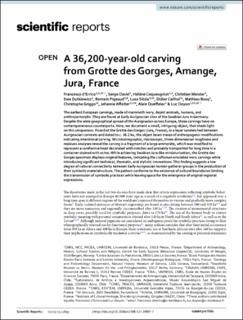| dc.contributor.author | d'Errico, Francesco | |
| dc.contributor.author | David, Serge | |
| dc.contributor.author | Coqueugniot, Hélène | |
| dc.contributor.author | Meister, Christian | |
| dc.contributor.author | Dutkiewicz, Ewa | |
| dc.contributor.author | Pigeaud, Romain | |
| dc.contributor.author | Sitzia, Luca | |
| dc.contributor.author | Cailhol, Didier | |
| dc.contributor.author | Bosq, Mathieu | |
| dc.contributor.author | Griggo, Christophe | |
| dc.contributor.author | Affolter, Jehanne | |
| dc.contributor.author | Queffelec, Alain | |
| dc.contributor.author | Doyon, Luc | |
| dc.date.accessioned | 2023-09-19T12:07:53Z | |
| dc.date.available | 2023-09-19T12:07:53Z | |
| dc.date.created | 2023-09-16T06:19:49Z | |
| dc.date.issued | 2023 | |
| dc.identifier.issn | 2045-2322 | |
| dc.identifier.uri | https://hdl.handle.net/11250/3090449 | |
| dc.description.abstract | The earliest European carvings, made of mammoth ivory, depict animals, humans, and anthropomorphs. They are found at Early Aurignacian sites of the Swabian Jura in Germany. Despite the wide geographical spread of the Aurignacian across Europe, these carvings have no contemporaneous counterparts. Here, we document a small, intriguing object, that sheds light on this uniqueness. Found at the Grotte des Gorges (Jura, France), in a layer sandwiched between Aurignacian contexts and dated to c. 36.2 ka, the object bears traces of anthropogenic modifications indicating intentional carving. Microtomographic, microscopic, three-dimensional roughness and residues analyses reveal the carving is a fragment of a large ammonite, which was modified to represent a caniformia head decorated with notches and probably transported for long time in a container stained with ochre. While achieving Swabian Jura-like miniaturization, the Grotte des Gorges specimen displays original features, indicating the craftsman emulated ivory carvings while introducing significant technical, thematic, and stylistic innovations. This finding suggests a low degree of cultural connectivity between Early Aurignacian hunter-gatherer groups in the production of their symbolic material culture. The pattern conforms to the existence of cultural boundaries limiting the transmission of symbolic practices while leaving space for the emergence of original regional expressions. | en_US |
| dc.language.iso | eng | en_US |
| dc.publisher | Nature | en_US |
| dc.rights | Navngivelse 4.0 Internasjonal | * |
| dc.rights.uri | http://creativecommons.org/licenses/by/4.0/deed.no | * |
| dc.title | A 38,000-year-old carving from Grotte des Gorges, Amange, Jura, France | en_US |
| dc.type | Journal article | en_US |
| dc.type | Peer reviewed | en_US |
| dc.description.version | publishedVersion | en_US |
| dc.rights.holder | Copyright 2023 The Author(s) | en_US |
| dc.source.articlenumber | 12895 | en_US |
| cristin.ispublished | true | |
| cristin.fulltext | original | |
| cristin.qualitycode | 1 | |
| dc.identifier.doi | 10.1038/s41598-023-39897-7 | |
| dc.identifier.cristin | 2175719 | |
| dc.source.journal | Scientific Reports | en_US |
| dc.relation.project | Norges forskningsråd: 262618 | en_US |
| dc.subject.nsi | VDP::Arkeologi: 090 | en_US |
| dc.subject.nsi | VDP::Archaeology: 090 | en_US |
| dc.identifier.citation | Scientific Reports. 2023, 13, 12895. | en_US |
| dc.source.volume | 13 | en_US |

